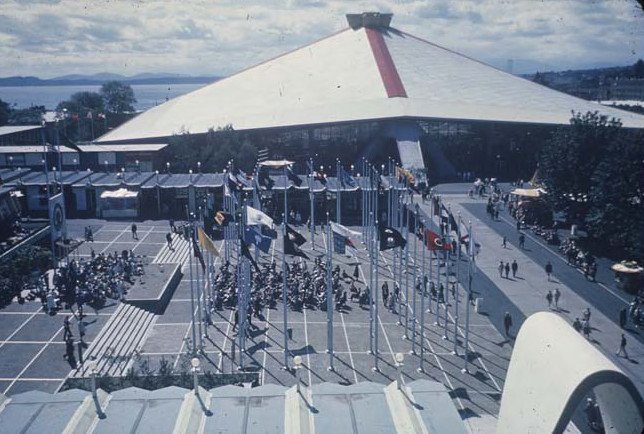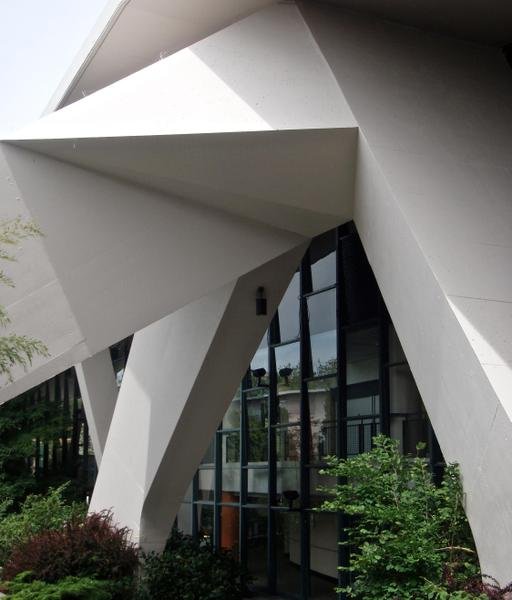Key Arena: Formerly the Coliseum
Let's landmark Key arena
The following article appeared in Crosscut on December 11, 2012. Although the Society is not referenced in the article, it is the result of an initiative by the Society's Board of Trustees to designate the Coliseum a City of Seattle Landmark.
Only one truly amazing Seattle Center building remains to be designated a City Landmark. It is the Key Arena. Meeting all six of the city’s criteria for landmark status, the Coliseum -- as it was previously known -- deserves recognition and protection from demolition as the city builds a replacement for it in Sodo. As Clair Enlow wrote on October 24, 2012 in the The Daily Journal of Commerce, “It is an architectural treasure and a landmark in every sense of the word, except legally.”
History of the Coliseum
Built for the 1962 Seattle World’s Fair, this spectacular structure is one of our city’s most graceful modern buildings and an exceptional testimony to the quality of post-war American engineering.
Designed by Paul Thiry, the fair’s principal architect and dean of Modernist Seattle design, the building is cherished as the original site of the Bubbleator. The Fair's transparent globe-shaped elevator lifted 100 visitors at a time up 28 feet to a structure of 3,500 interlocking multicolored aluminum cubes, where elevator riders were given a 21-minute tour of the future in the World of Tomorrow exhibition. In designing the Coliseum, Thiry worked closely with structural engineer Peter Hostmark, creating a hyperbolic-paraboloid roof structure whose swooping lines are as distinctive as the domes on Minoru Yamasaki’s Pacific Science Center and the spinning top of John Graham, Jr. and Victor Steinbrueck’s fanciful Space Needle.
Financed by the State of Washington and built at a cost of $4,500,000, the Washington State Pavilion was renamed the Coliseum following its conversion to a sports arena after the Fair. The building was located at the center of the International Plaza and ringed by the International Commerce and Industry Buildings, part of the World of Commerce and Industry -- all of which were Paul Thiry’s work.
Uniquely responsible for bringing European modernism to Seattle, Thiry produced the Northwest Rooms, the Alki Room, the Swedish Building, and the now demolished Seattle Center Pavilion. He is especially significant as the chief urban planner for the development of the World’s Fair site, and his mark can be found in unexpected places, such as his design for the back of the Horiuchi Mural.
The Coliseum’s exterior glass walls are set within V-shaped units and enclose nearly 130,000 square feet of space. Under the majestic roof, the interior has a series of ramps around the enclosed arena at the center. Entrances at various levels are situated around the building.
Alterations to the Structure
Shortly after the conclusion of the Seattle World’s Fair Century 21 Exposition, alterations were made to convert the structure from an exhibition hall to a sports and multi-purpose facility. This conversion consisted of a reconfiguration of the interior spaces and the installation of new access ramps and partition walls. Like later renovations made in 1993, these alterations did not substantially alter the building’s basic form or its distinctive profile.
After its conversion to a sports arena, the Coliseum hosted the SuperSonics, one of this city’s beloved sports franchises. Today, the building holds a pivotal role in the history of Seattle’s feminist movement as the home of the Storm, now the only women’s sports team in America wholly owned by women. The myriad of international stars who have performed there make it nearly hallowed ground: Madonna, Pete Seeger, Bob Dylan, the Beatles, Radiohead, Nirvana, Barack Obama. The list is endless.
Meets Landmark Standards
Emotionally, architecturally and historically, there is no doubt that the Coliseum is a landmark.
As the city embraces a study of Seattle Center’s future, nominating the Coliseum as a historic landmark must be part of the process. To be designated a landmark, a building must be at least 25 years old and meet at least one of the six criteria for designation. Of the hundreds of buildings that have been designated historic Seattle landmarks, only two -- the Space Needle and the Pacific Science Center -- have met all six of them.
The Coliseum also meets all six landmark standards. They are restated briefly here with some of the most obviously compelling reasons for designation:
It is the location of a historic event with a significant effect upon the community: World’s Fair, SuperSonics, Storm, Bumbershoot, Seattle Center.
It is associated with the life of a person important in the history of the city, state, or nation: Paul Thiry, Ewen Dingwall, Joe Gandy, Bagley Wright, Governor Al Rosellini, Elvis Presley, Barack Obama, Pete Seeger and many others.
It is associated in a significant way with a significant aspect of the cultural, political, or economic heritage of the community: sports, culture, Seattle Center.
It embodies the distinctive visible characteristics of an architectural style, or period, or a method of construction: modernism, building engineering of second half of the 20th C.
It is an outstanding work of a designer or builder: Paul Thiry’s most impressive work.
It is an easily identifiable visual feature of its neighborhood or the city and contributes to the distinctive quality or identity of such neighborhood or the city. While it doesn’t scream Seattle, Seattle Center and the City of Tomorrow quite as loud as the Science Center or the Space Needle, the Coliseum is definitely one of the cornerstones of the World’s Fair site and is easily recognized from many vantage points.
In addition to meeting at least one of the six standards, a building must also possess integrity or the ability to convey its significance.
Significant Alterations
The alterations to the building have been significant, but the dramatic structure and its four-acre footprint were designed to make changes easy and frequent. In an unusual twist of the integrity concept, making changes to the Coliseum respects the integrity of its design.
A 1993 photograph of Mayor Norm Rice announcing the Coliseum’s new name shows a building awaiting the reinstallation of the roof, a deeper bowl, new seats and a modified ramp and loading dock on the building’s south side. The massive interlocking steel trusses, the tripedal concrete buttresses from which the roof cabling and the roof are suspended and the window walls -- its most significant features -- are intact today. Enclosing a huge amount of unobstructed space, the building was designed to be flexible and alterable. Even today, its gigantic open span makes it work for basketball, hockey, concerts and even the occasional Bumbershoot film.
Paul Thiry incorporated the idea of changing interior shapes in his design. From the very beginning, Thiry anticipated the conversion of the Coliseum to an 18,500-seat sports and convention facility at the conclusion of the fair. Consequently, when assessing the building’s qualifications as a City of Seattle landmark, its design flexibility is paramount. The Coliseum was engineered for change. Just as the fair envisioned the future, so the building -- an amazing example of adaptable space -- embodies it.
Perils of Losing the Coliseum
The peril of losing the Coliseum is increasing in the rush to embrace a new stadium for still-unidentified basketball and hockey teams. Local politicians – including Queen Anne-based state legislator Reuven Carlyle (D) and its newly-minted mayoral candidate, City Councilmember Tim Burgess – have written the building off as a white elephant.
Seattle architecture critic Lawrence Cheek underscored the danger to the Coliseum in a June 3, 2010 article in The Seattle Times.
“It's appalling that Seattle continues abandoning major civic buildings after just 20, 30 or 40 years. I don't think anybody misses the Kingdome or the old Central Library, but Key Arena is a superb building, and it did not deserve to be orphaned.”
Seattle Center just concluded its celebration of the 50th anniversary of the 1962 Seattle World’s Fair and focused the celebration on the next 50 years. The Coliseum merits the same protections as its siblings, the Space Needle and the Pacific Science Center. They were built for Seattle’s future. Just as a 1962 film heralding the fair said, “See… the gigantic, wall-less, pillorless Coliseum and have fun with the happy-go-lucky crowd!”
Now, after 50 years, we can add, “Forever!” Only landmark designation can make it happen.
This article was originally published at Crosscut.com.
For Further Reading
In 2020, Key Arena transitioned to Climate Pledge Arena


